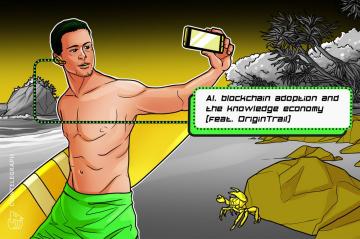2022 was the year the wheels fell off the metaverse bandwagon, which had been the most hyped narrative as the year began. By far the worst-performing sector in blockchain, the average drawdown was 89%.
Even Facebook’s grand plans to dominate the metaverse are in disarray; it’s losing more than $1 billion a month, while the flagship “Horizon Worlds” attracts fewer than 200,000 users per month.
But amid all the gloom, there are still miles of runway left from unprecedented fundraising and signs from The Sandbox, play-to-earn games and niche metaverse platforms that 2023 will be much more productive.
Sébastien Borget, chief operations officer and co-founder of The Sandbox, has been on the road a lot lately visiting the company’s new offices. He speaks from Argentina when we talk just before Christmas about the performance of metaverse platforms in 2022.
Many pundits say it’s been a mixed year at best for adoption, pointing to DappRadar statistics that appeared to indicate daily average visitors to The Sandbox were as low as 500, with just 50 people wandering about Decentraland. However, both companies actively pushed back on these stats, claiming the figures only reflected the number of daily users who made a transaction — not the number of daily visitors overall.
Borget is dismissive of the low figures quoted and says there are on average 30,000 visitors every day to the metaverse platform. He expects a surge in user numbers when the platform goes mobile later this year.
“That will make a big difference. 30,000 is still a small number when compared to Facebook for example,” he says.
“But when you enter The Sandbox, you see people running around – it is full.”
The Sandbox Alpha Season 3 has claimed 17 million visits since Aug. 24, a threefold increase over Season 2. That’s even more astonishing when you consider the word Alpha means it’s still in the earlier stages of development.
So, while 2022 was definitely the year that the word “metaverse” became a household name — and was narrowly beaten to the Oxford Dictionary’s word of the year by “goblin mode” — there’s hope that 2023 will see it gain wider adoption. McKinsey Global revealed that investors had tipped $120 billion into developing metaverse tech by June, and even though funding subsequently fell off a cliff, that’s a lot of runway to produce the goods in 2023.
 Iceland in The Sandbox
Iceland in The SandboxThe Sandbox is one of the metaverse OGs, founded four years ago, hosting impressive land sales topping $530 million, and attracting big names, such as SnoopDogg.
Borget points out that staffing has doubled over the previous year, and the project has a financial runway of at least five years. The big push to attract more users is coming from design studios and builders who are using their digital land to create experiences.
“There are 230 studios currently building on Sandbox, and that is only the beginning. We also see cultural experiences becoming popular when different nationalities have created a home from home in the metaverse,” says Borget.
Can metaverse replace the real world?
Upland, also founded four years ago, is a virtual property trading game mapped to the real world on the EOS blockchain platform and is often described as Monopoly on the blockchain. The Sandbox and Upland are both parts of the Open Metaverse Alliance, which is chaired by Upland co-founder and CEO Dirk Lueth.
“When we founded Upland in 2018, very few people had even heard of the word ‘metaverse,’” says Lueth, noting that these days, “the future is at least envisioned — I’d call that progress.”
 Upland partnered with FIFA World Cup to offer an online games element for fans. Source: Upland
Upland partnered with FIFA World Cup to offer an online games element for fans. Source: UplandHe says the high point is the attention from non-crypto native audiences and brands. $2 billion has been spent on virtual land across metaverse platforms in the past 12 months as people and companies race to get a foothold in this new virtual territory.
“At Upland, we are proud to have the largest number of unique landowners [more than 290,000] who come to socialize, create value, and build communities,” says Lueth.
There is a core segment of users who are creators or meta-entrepreneurs who are building their own businesses in the metaverse. Artists can create decor items and sell them to other users, while others have opened shops for secondary sales of NFTs. One of the big factors drawing users in, and keeping them engaged, are the virtual communities that are emerging. In Upland, they are called “nodes.”
“We also find that users who are part of communities tend to stay more, and much of their activity is around building their communities.”
“Some of them have game nights, create charity fundraising events together, make governance decisions about what to build in their neighborhoods, and even elect representatives. Some communities are formed around similar interests — like racing, which is a feature in Upland. They’ve created racing leagues, are building their neighborhood tracks and creating digital assets for rewards,” says Lueth.
Digital goods as the killer app
Digital ownership is often touted as the breakthrough factor for mass adoption along with the interoperability of assets across platforms. However, Alien Worlds chief marketing officer Kevin Rose points out that a lightsaber from one world would not necessarily translate into a medieval tournament. “It doesn’t always make sense,” he argues.
 Different land types are available from Alien Worlds. Source: Alien Worlds
Different land types are available from Alien Worlds. Source: Alien WorldsAlien Worlds is an NFT-driven game in which users collect and trade unique digital items minted primarily on the Wax blockchain. Players compete to earn Alien Worlds’ in-game token, Trilium (TLM), which is needed to control one of the six rival DAOs.
Marja Konttinen, marketing director of the Decentraland Foundation, puts forward a compelling case for digital ownership in a different context: fashion. Decentraland is a 3D virtual world browser-based platform that opened to the public in February 2020.
“Let’s look at one use case for the metaverse where ownership will be fundamental: fashion. If you don’t have a wallet to log in, it will be hard for you to experience digital fashion at its finest because you can’t claim any wearables to add to your wardrobe,” says Konttinen.
Read also
FeaturesBanking The Unbanked? How I Taught A Total Stranger In Kenya About Bitcoin
FeaturesCrypto Pepes: What does the frog meme?
Others are banking on a combination of community with the appeal of new experiences made possible through fast-developing technology. Unlike most other metaverse platforms, which are still accessed via screens, Somnium Space is an immersive virtual reality-based metaverse built on the Ethereum blockchain. It launched in 2017. Interviewing its founder and CEO Artur Sychov entails a chat with his avatar.
Somnium Space is creating its own custom VR headsets. Since Sychov spends as many as several hours each day in his, he is well placed to provide feedback on comfort and features.
 Artur Sychov, founder of Somnium Space in his headset. Source: Somnium Space
Artur Sychov, founder of Somnium Space in his headset. Source: Somnium SpaceCompared with some of the bigger names, Somnium Space is still scaling up. There have been more than 250,000 downloads so far, which translates into 80–150 daily visitors in VR and another 1,000–2,000 users on the screen-based web client.
“Immersive” is what Somnium Space is all about, and visitors can compete in sports, attend discos, and actively participate in whatever’s going on.
“Since it’s VR, if I am kayaking, then I am moving my arms and it is tiring – same as in real life,” says Sychov.
“That’s the power of VR – if I’m dancing, then I’m dancing not just hitting a button that causes my avatar to move. People understand that you are actually present with them – at social events or meetings.”
Sychov views the future of metaverse platforms, such as Somnium Space, as dependent on the people they attract and their ownership. He says that 90% of landowners on the platform have bought their land to build on it, giving the platform stickiness and keeping the owners coming back from more.
Sychov has augmented the land with a new concept of “worlds.” Entry is via a stargate, and inside these new worlds, there is no limit to the space, building or action. He shows me how his avatar steps inside a gate to a world and immediately is in a new space.
“Individuals and companies are buying these worlds – it’s all about building,” he says, echoing Borget’s excitement over the increased activity by design studios over in The Sandbox. It might still be crypto winter, but that’s when the builders emerge.
Great minds think alike:
Keep building, lads. Don't get distracted.
— CZ




























































